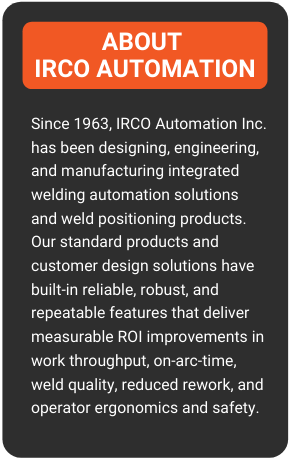Welding has changed over time – technology and the growing demands in the workplace have reshaped the way companies fabricate, weld and manufacture. The introduction of welding automation (including robotic/flexible automation and mechanized/hard/fixed automation) has provided companies with new options and ways to improve their manufacturing and welding processes. However, transitioning from manual welding to automated welding (or positioning/movement of parts) can be an overwhelming road for companies to navigate. They may find themselves asking:
- What is Welding Automation? (Learn more)
- What types of Welding Automation are there? (Learn more)
- Why should I even bother automating? What are the benefits?
In this post, we’re going to address those last two questions:
What are the Benefits of
Welding Automation?
The answer anyone can tell you: There are many different benefits to adding automated welding into your process. However, the specific benefits you’ll care most about will greatly depend on what you’re looking to achieve or improve in your own process line. What is your reason for automating? What are the greatest challenges that you want to solve? Having clear answers to these types of questions and a predetermined ROI maps out the benefits you’d be most interested in welding automation for.
To keep things simple, here’s a quick list of 8 benefits that we know our solutions have helped customers address.
[READ MORE BELOW THE INFOGRAPHIC]
.png?width=800&name=8%20benefits%20of%20welding%20automation%20%20(1).png)
Welding Automation can help reduce safety hazards
-
Preprogrammed part positioning, welding motion, and integrated safety devices (ie. area scanners), means there’s less exposure and less need for operators to be in the "work zone"
-
The use of weld positioners leads to less material handling (reducing the use of equipment, chains, or cranes), meaning there's fewer part pick-ups or flips during the welding process; thereby improving overall operator safety.
Welding Automation can Improve your weld quality
-
Automated torch placement and height control in the weld joint improves overall weld quality
-
Repeatable torch placement helps reduce the number of poor-quality welds
-
With better wire placement into the weld joint the weld quality is improved
-
Taking advantage of the enhancements found in modern "smarter" welding equipment
Welding Automation can help you gain greater repeatability for your welds
-
By taking advantage of proven processes and automating these, everything is repeatable and consistency is achieved
- With PLC programming imbedding into the work process flow the dependence on a skilled operators or welder is reduced; everything is completed the same way, every time
Welding Automation can Reduce your Cycle Times / Welding Automation can Increase your Productivity and Output
-
Welding faster with an automated system improves the cycle times for part fabrication
-
Reducing the amount of human intervention allows for predicable and repeatable production runs
-
Welding systems that can run autonomously allow operators/welders to multitask on other functions to enhance production output
Welding Automation can reduce your production waste
-
By maximizing a preprogrammed weld procedure, wear-part life is maximized while welding faster
-
Excess weld reinforcement, that increases the usage of weld wire and arch time, is reduced when the weld process is controlled along with the part placement
-
By using positioning equipment, crane time and need for forklifts is greatly reduced
Welding Automation helps address the growing shortage of qualified welders
-
There is a growing shortage of qualified welders in North America - this is a looming worry for many manufactures. By automating your weld process (or parts of it) your welders can be “freed up” to work on other task while that machine autonomously welds, or trained operators can run the machines.
Welding Automation can help reduce your costs
-
Reducing your long-term costs of manual welding and reducing your reliance on multiple skilled welders.
-
Production monitoring on these systems can help identify cost inefficiencies or optimization opportunities
Welding Automation can offer a powerful opportunity for production monitoring
-
Components of automated systems (ie. PLCs, sensors, etc.) make it possible add weld production monitoring systems. These systems autonomously collect, digitizes, report production metrics.
-
IRCO’s weld production monitoring system is called IRCOpulse. To learn more about production monitoring systems, click here.
There are several challenges that welding automation and help solve and provide. IRCO Automation’s automated welding systems are designed to meet each customer’s specific ROI. And, as each customer is unique, the solutions IRCO designs and the benefits they offer range from system to system.
We’re ready to help provide solutions to the challenges you’re facing! Connect with our team today by filling out a form or scheduling a call with one of our automation specialists.
If you are interested in learning more about welding automation check out the following resources:

.png)
.png?width=600&name=Author%20Headers%20(7).png)

